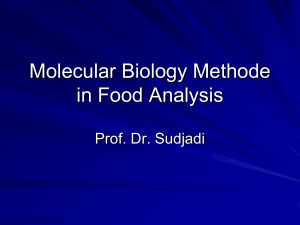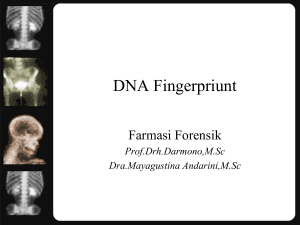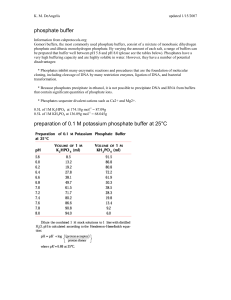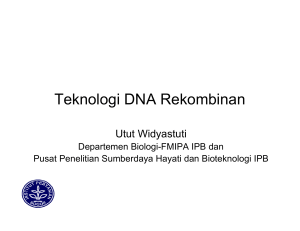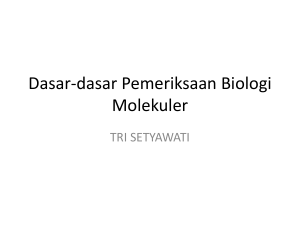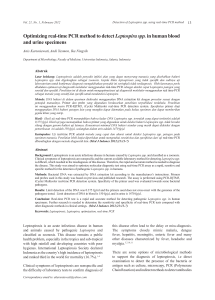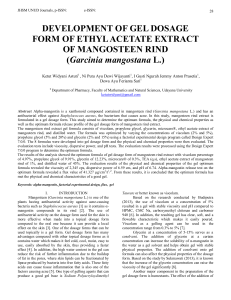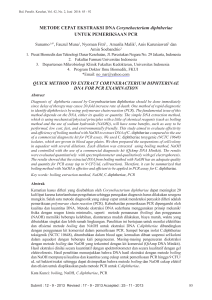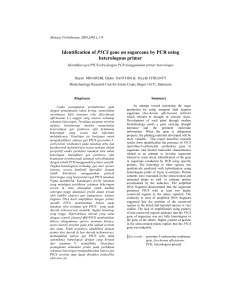37-44
advertisement
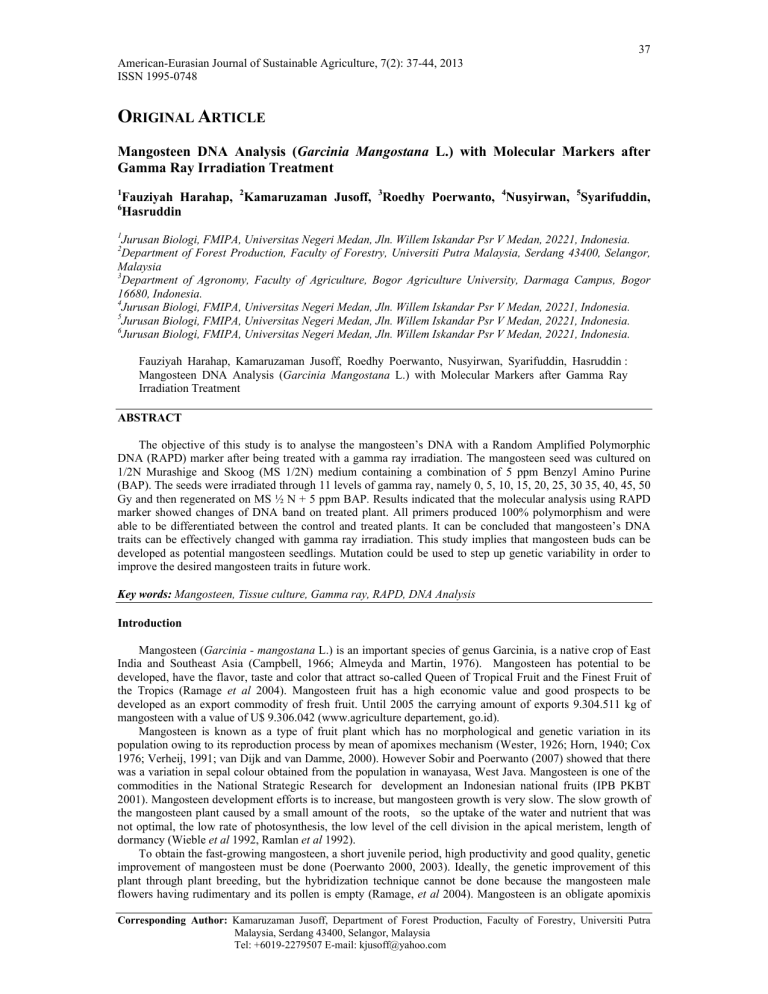
37 American-Eurasian Journal of Sustainable Agriculture, 7(2): 37-44, 2013 ISSN 1995-0748 ORIGINAL ARTICLE Mangosteen DNA Analysis (Garcinia Mangostana L.) with Molecular Markers after Gamma Ray Irradiation Treatment 1 Fauziyah Harahap, 2Kamaruzaman Jusoff, 3Roedhy Poerwanto, 4Nusyirwan, 5Syarifuddin, Hasruddin 6 1 Jurusan Biologi, FMIPA, Universitas Negeri Medan, Jln. Willem Iskandar Psr V Medan, 20221, Indonesia. Department of Forest Production, Faculty of Forestry, Universiti Putra Malaysia, Serdang 43400, Selangor, Malaysia 3 Department of Agronomy, Faculty of Agriculture, Bogor Agriculture University, Darmaga Campus, Bogor 16680, Indonesia. 4 Jurusan Biologi, FMIPA, Universitas Negeri Medan, Jln. Willem Iskandar Psr V Medan, 20221, Indonesia. 5 Jurusan Biologi, FMIPA, Universitas Negeri Medan, Jln. Willem Iskandar Psr V Medan, 20221, Indonesia. 6 Jurusan Biologi, FMIPA, Universitas Negeri Medan, Jln. Willem Iskandar Psr V Medan, 20221, Indonesia. 2 Fauziyah Harahap, Kamaruzaman Jusoff, Roedhy Poerwanto, Nusyirwan, Syarifuddin, Hasruddin : Mangosteen DNA Analysis (Garcinia Mangostana L.) with Molecular Markers after Gamma Ray Irradiation Treatment ABSTRACT The objective of this study is to analyse the mangosteen’s DNA with a Random Amplified Polymorphic DNA (RAPD) marker after being treated with a gamma ray irradiation. The mangosteen seed was cultured on 1/2N Murashige and Skoog (MS 1/2N) medium containing a combination of 5 ppm Benzyl Amino Purine (BAP). The seeds were irradiated through 11 levels of gamma ray, namely 0, 5, 10, 15, 20, 25, 30 35, 40, 45, 50 Gy and then regenerated on MS ½ N + 5 ppm BAP. Results indicated that the molecular analysis using RAPD marker showed changes of DNA band on treated plant. All primers produced 100% polymorphism and were able to be differentiated between the control and treated plants. It can be concluded that mangosteen’s DNA traits can be effectively changed with gamma ray irradiation. This study implies that mangosteen buds can be developed as potential mangosteen seedlings. Mutation could be used to step up genetic variability in order to improve the desired mangosteen traits in future work. Key words: Mangosteen, Tissue culture, Gamma ray, RAPD, DNA Analysis Introduction Mangosteen (Garcinia - mangostana L.) is an important species of genus Garcinia, is a native crop of East India and Southeast Asia (Campbell, 1966; Almeyda and Martin, 1976). Mangosteen has potential to be developed, have the flavor, taste and color that attract so-called Queen of Tropical Fruit and the Finest Fruit of the Tropics (Ramage et al 2004). Mangosteen fruit has a high economic value and good prospects to be developed as an export commodity of fresh fruit. Until 2005 the carrying amount of exports 9.304.511 kg of mangosteen with a value of U$ 9.306.042 (www.agriculture departement, go.id). Mangosteen is known as a type of fruit plant which has no morphological and genetic variation in its population owing to its reproduction process by mean of apomixes mechanism (Wester, 1926; Horn, 1940; Cox 1976; Verheij, 1991; van Dijk and van Damme, 2000). However Sobir and Poerwanto (2007) showed that there was a variation in sepal colour obtained from the population in wanayasa, West Java. Mangosteen is one of the commodities in the National Strategic Research for development an Indonesian national fruits (IPB PKBT 2001). Mangosteen development efforts is to increase, but mangosteen growth is very slow. The slow growth of the mangosteen plant caused by a small amount of the roots, so the uptake of the water and nutrient that was not optimal, the low rate of photosynthesis, the low level of the cell division in the apical meristem, length of dormancy (Wieble et al 1992, Ramlan et al 1992). To obtain the fast-growing mangosteen, a short juvenile period, high productivity and good quality, genetic improvement of mangosteen must be done (Poerwanto 2000, 2003). Ideally, the genetic improvement of this plant through plant breeding, but the hybridization technique cannot be done because the mangosteen male flowers having rudimentary and its pollen is empty (Ramage, et al 2004). Mangosteen is an obligate apomixis Corresponding Author: Kamaruzaman Jusoff, Department of Forest Production, Faculty of Forestry, Universiti Putra Malaysia, Serdang 43400, Selangor, Malaysia Tel: +6019-2279507 E-mail: [email protected] 38 Am.-Eurasian J. Sustain. Agric. 7(2): 37-44, 2013 seeds, the embryo develop from nusellus cells in the ovule tissue. Mangosteen embryo is somatic embryo that is genetically inherited from female plants. Reproduction mechanisms, including categories of adventitious/nuclear embryony, development of embryos adventitious from the outer integument, whithout of stimulation of sexual development (Richard 1990). Induction of mutations contributing an increase of plant genetic diversity, and with the selection, we can get the potential mutants. The use of irradiation has provided a positive impact on increasing the number of new plant varieties. Alternative mangosteen plant breeding can be done with the induction of mutations. Artificial mutation by irradiation can create genetic variation in the mangosteen. On woody plants, has produced varieties of guava fruit, citrus, palm and Japanese pear (Jain 2000). Institute of Radiation Breeding in Japan have been using mutation induction in 1969 for potential mutants. Until 1998, the apples, sugar cane, rice, barley, ornamental plants have been release (Institute of Radiation Breeding 2001), as well as other food crops and horticulture (Harten 1998). Mutations by irradiation can increase genetic variation. Cells that can well survive after irradiation will have some physiological or genetic changes. These changes can produce plants that look better (superior plants) than before. DNA is the main target of giving mangosteen irradiation to cause mutations and increasing genetic diversity. Chimera can be reduced by repeated multiplication, so that it will obtain a solid mutants. In the previous studies have developed methods of direct organogenesis, mangosteen medium modification and explants cutting pattern (Harahap, 2006a), also conducted research on the isozyme changes analysis of in vitro mangosteen after irradiation (Harahap, 2006b). The purpose of this study was to in vitro mangosteen DNA analyze results gamma rays iriradiation with RAPD molecular markers Materials and Methods The plant material was obtained from a farmer’s mangosteen plantation in Siboloangit, North Sumatra. Seeds were planted in the in vitro culture with ½ N MS medium + 5 ppm / l BAP (Harahap, 2006a), and then irradiated. Irradiation doses given were 0, 5, 10, 15, 20, 25, 30, 35, 40, 45, 50 Gy. Explants regenerated on ½ N MS medium + 5 ppm BAP. The sample is the second and the third leaves of the shoots from in vitro culture. Isolation of total DNA using the Doyle and Doyle method with modification (Doyle and Doyle 1987), researcher make a modification with the addition of Poly Vinyl Poly Pirolidon (PVPP) at the time of grinding the leaves and the addition of the incubation buffer at the time of the extract. The test of DNA quantity and quality (Sambrook et al, 1989; Mathius & Hutabarat, 2001) would be done with a UV-VIS at λ 260-280 nm and electrophoresis. Primers used in this study were random primer, namely are OPH 12, OPH 13, OPH 18, SB 12, SB 13, SB 16, SB 19, OPN 4, OPN 12, OPN 16 (Operon Tech Alameda, California). Mangosteen DNA was diluted to a concentration of 50 ng / µl, 2 µl DNA solution was taken, mixed with PCR reagents (master mix = 18.8 µl ion-free H20, 2.5 µl Polymerase DNA Taq buffer 10x / 15 mM MgCl2, 0.5 µl 10 mM dNTPs, 1 µl primer 10 pmol / µl ; 0.2 µl Taq DNA polymerase 5 units / µl and 25 µl of mineral oil), then the mixture is inserted into the PCR machine and run a program of denaturation at 94 °C for 1 minute, annealing 36 °C for 1 minute, extension 72 °C for 2 minute, the process was carried out as many as 45 cycles. Five µl PCR solutions was mixed with 1 ml loading dye, and then was r to the electrophoresis machine with 1x TAE buffer and 1.4% agarose gel for 1.5 hours. The electrophoresis products were then placed on the UV transluminator and photos were taken for record purposes. The analysis was carried out by comparing the irradiated plants RAPD band pattern with band of control plants to see any changes. RAPD data form is a DNA banding pattern of a certain size. Pieces of genomic DNA were measured by comparing the molecular weight marker 1 kb ladder. Differences between plants are shown by the number of bands and migration distance. Results and Discussion Mangosteen DNA isolated is very difficult. Amount of DNA isolated is very small compared to other plants with the same number of samples. DNA isolation results obtained the pellets, but when be analyzed by electrophoresis, turned out a little amount of DNA, some of DNA remain in the gel wells (Fig. 1). DNA yield was 20-120 ng / µl from 0.2 g leaf extracts. PCR on a sample of 80 plants with 10 primers produced 98 bands. All of primer produces 100% polymorphism, except OPH 13 primer, showed 80% polymorphism, and SB 12 produce only 50% polymorphism. The average level of polymorphism was 93.9% from 10 primers (Table 1). Amplification with the primer OPH 12 produced 8 bands. Control plants had all these bands. Irradiation plants generally lose the band. Plant No.14 looses all of its band amplification with such primer. Plant No.24 and 46 have a band pattern similar to control plants. Several other plants lose the band number 2, 3, 4, 5, 6, 7 and 8. Most plants (60 plants) had lost the band number 8 (Figure 2). The results of amplification with the primer OPH 13 earned 10 bands. Control plants did not have the band 10. The banding patterns of Plant No. 27 are the same as of the control plants (Figure 3). Most plants lost the band when amplification with this primer 39 Am.-Eurasian J. Sustain. Agric. 7(2): 37-44, 2013 was undertaken. Plants that lose the band number 1, 2, 3, 4, 5, 7 and 9 are the consecutive from numbers of plants 42, 59, 49, 50, 43, 69 and 9. There are 42 plants which have additional band 10th. The results of PCR with 10 primers showed that the irradiated plants showed some banding pattern, the pattern of the band together with control plants, the plants lose some RAPD bands, some plants have additional RAPD bands, some plant loss RAPD bands that exist and have the addition of new bands, some plant loss throughout the band. Irradiation treatment gives the respond in addition to the new bands and lost their bands when comparison with native plants. In general, the number of bands that emerged was one. The greatest number is the result of amplification with the primer OPH 13 where 42 plants have the addition of a band, with the other primer contained 3 to 12 plants had the addition of a band. Only a few plants with a specific primer that addition amplification of two bands. The addition of 3 bands on amplification with primers OPN 4 resulted in the amplification with the primer OPH 12 showing the abundance of plants (17 plants) lost a band. Only one plant ever lost 6 bands, amplification with the primer OPH 13 showed 27 plants lost 6 bands and the smallest amount of plant (4 plant) loss are 3 bands. Fig. 1: The results of DNA isolation, mangosteen leaves (control and the gamma ray irradiation treatment). Description: M = Marker.1 to 30 = number of plants Fig. 2: PCR results of DNA banding pattern with primer OPH 12. M = Marker, .1-80 = number of plants. = No. 14, showed no amplification. = Number 24, banding pattern similar to controls. = Number 41,42,43,44 5,3,3,3 lost ribbon. = No. 61, 62, 63, 64 = loss of 6, 4, 5, 3 ribbons. = No. 69 lost 5 bands 40 Am.-Eurasian J. Sustain. Agric. 7(2): 37-44, 2013 Fig. 3: PCR results of DNA banding pattern with primer OPH 13. M = Marker, .1 - 80 = number of plants. = Number 12,15,16 loss of ribbon into 1, 2, 3, 4, 5, 7, 9. = Number 27, the ribbon pattern similar to control plants. = Number of plants that have the addition of 36 ribbon to 10. = Number 74-79 to lose a few bands Fig. 4: The number of plants based on the missing band in each amplification primer. Fig. 5: The number of plants that grow on the ribbon on the amplification of each primer. The results of amplification with OPH 18, SB 12 and OPN 12 primer, there is at most the number of plants 17, 40 and 40 plants lose a band. Amplification with SB 13 and SB 16 show the highest number of consecutive 29 and 24 plants lose two bands (Table 2) 41 Am.-Eurasian J. Sustain. Agric. 7(2): 37-44, 2013 Fig. 6: The number of plants that additional band on each primer. Amplification with OPN 16 shows the 24 plants lost 3 bands. Graph showing the comparison of the number of plants lost RAPD bands for each primer shown in figure 4. Some irradiation plants lose the entire band results in the amplification process with a specific primer. To ensure that the DNA cannot amplify because the gamma ray irradiation treatment, the same DNA PCR performed again using the previously used primers and amplified with primers that always. DNA used as a comparison to other mangosteen amplified. Plants that lose all RAPD bands with specific primers are presented in Table 15. Table 1: The number of band result PCR with 10 randamly primer at 80 mengosteen. No Primer Susunan Nukleotida Jumlah Pita 5’…….3’ 1 OPH 12 ACGCGCATGT 8 2 OPH 13 CACGCCAC AC 10 3 OPH 18 GAATCGGCCA 10 4 SB 12 TGCCGACCTG 8 5 SB13 AGTCAGCCAC 8 6 SB16 GTGATCGCAG 7 7 SB 19 CAGCACCCAC 9 8 OPN 4 CACCGACCCA 13 9 OPN 12 CACAGACACC 8 10 OPN 16 AAGCGACCTG 17 Jumlah 98 Table 2: The number of plants that lose RAPD bands for each primer Total Band Loss OPH 12 OPH 13 OPH 18 SB 12 0 2 1 27 15 1 17 6 17 40 2 14 9 3 8 3 14 4 8 4 11 8 6 5 4 7 5 6 1 27 1 7 8 2 Total 1 2 - SB 13 21 4 29 8 3 4 1 Table 3: The number of plants that have additional bands in each RAPD primer Jumlah pita yang OPH OPH 13 OPH 18 SB 12 SB 13 bertambah 12 1 42 3 7 2 3 3 - Pita polimorfik Pita Monomorfik 8 (100%) 8 (80%) 10 (100%) 4 (50 %) 8 (100%) 7 (100%) 9 (100%) 13 (100%) 8 (100%) 17 (100%) 92 (93,9%) 2 4 6 SB 16 16 22 24 3 3 OPN 4 22 11 3 7 5 7 4 1 OPN 12 1 40 23 4 5 1 OPN 16 17 19 24 7 9 8 2 SB 16 SB 19 OPN 4 OPN 12 OPN 16 6 1 - 6 - 10 3 3 3 - 12 10 - Table 4: The number of plants that lose a certain band on each primary Primer Pita ke K 1 2 3 4 5 6 7 8 9 OPH 12 2 4 3 16 24 1 37 15 60 OPH 13 1 42 59 49 50 43 69 9 OPH 18 27 16 37 4 23 2 21 7 SB 12 2 11 14 29 SB 13 21 45 39 14 13 6 SB 16 16 48 28 3 SB 19 49 15 12 3 2 5 OPN 4 22 16 28 30 16 1 OPN 12 1 29 6 1 66 1 OPN 16 16 34 22 11 Description: K = number of bands equal to the control plants, S = all the bands disappear. SB 19 49 11 4 3 1 1 1 10 5 32 - 11 26 8 12 53 13 64 16 6 S 1 2 1 3 1 1 1 2 42 Am.-Eurasian J. Sustain. Agric. 7(2): 37-44, 2013 Table 5: The number of plants that have additional specific bands in each primer PRIMER Pita ke 1 2 4 6 7 9 OPH 12 OPH 13 OPH 18 4 5 SB 12 7 SB 13 SB 16 7 1 SB 19 6 OPN 4 7 6 10 OPN 12 3 OPN 16 1 20 - 10 42 6 13 2 - 14 2 15 7 Table 6: The number of plants that lose RAPD band for each primer PRIMER Pita ke 1 2 4 6 7 OPH 12 OPH 13 OPH 18 4 5 SB 12 7 SB 13 SB 16 7 1 SB 19 6 OPN 4 7 6 OPN 12 3 OPN 16 1 20 - 10 42 6 13 2 - 14 2 15 7 9 10 - Table 14: The number of plants that have additional bands in each RAPD primer Jumlah pita yang OPH OPH 13 OPH 18 SB 12 SB 13 bertambah 12 1 42 3 7 2 3 3 - SB 16 SB 19 OPN 4 OPN 12 OPN 16 6 1 - 6 - 10 3 3 3 - 12 10 - Table 15: The mangosteen result gamma irradiation that lost all RAPD bands with specific primer No Nomor tanaman Nomor kode tanaman Hasil perlakuan 1 5 2.10.1 Pohon 2 ; 10 gy ; eksplan ke 1 2 5 2.10.1 Pohon 2 ; 10 gy ; eksplan ke 1 3 14 2.40.1 Pohon 2 ; 40 gy ; eksplan ke 1 4 14 2.40.1 Pohon 2 ; 40 gy ; eksplan ke 1 5 14 2.40.1 Pohon 2 ; 40 gy ; eksplan ke 1 6 29 5.40.1 Pohon 5 ; 40 gy ; eksplan ke 1 7 33 13.5.1 Pohon 13 ; 5 gy ; eksplan ke 1 8 33 13.5.1 Pohon 13 ; 5 gy ; eksplan ke 1 9 47 13.30.1 Pohon 13 ; 30 gy ; eksplan ke 1 10 49 2.35.1 Pohon 2 ; 35 gy ; eksplan ke 1 11 51 13.40.1 Pohon 13 ; 40 gy ; eksplan ke 1 12 52 13.40.2 Pohon 13 ; 40 gy ; eksplan ke 2 Jenis primer OPN 16 SB 16 OPH 12 SB 19 OPN 12 OPH 18 OPN 4 OPN 16 SB 13 OPH 18 SB 16 SB 16 DNA isolation results obtained showed that the yield is very low when compared with other crops, such as orchids, orchids of 0.3 grams of leaves obtained 50-375 ng / µl DNA (Kartikaningrum 2004). This is probably caused by a number of mixed contaminants in the DNA, such as polysaccharides that have properties such as DNA. Mangosteen contains polysaccharides such as gum and other woody plants that can interfere with DNA isolation process. Mathius et al., (1999), states that polyphenolic compounds are contaminants that interfere with DNA purification process and often leads to failure in isolating and purifying DNA. From the results obtained shows that this marker is capable and can be used to see the changes in plants due to irradiation of the mangosteen. It is seen from a high level of polymorphism. The use of physical mutagen through gamma-ray irradiation leads to changes in the cell. The changes are evident from its ability to grow, change shape, the percentage of explants that life post-irradiation as well as the emergence of different phenotypes of the control plants (Harahap 2003; 2005). Bhagwat and Duncan (1998), said the mutation frequency increases with increasing radiation dose and dose rate, although survival and regeneration ability decreased with increasing dose. Each plant has a different sensitivity to irradiation or light of ionisation, even between varieties of the same species also have a sensitivity of different (Hussin, 2002). Harten (1998), said external factors such as humidity, moisture content, oxygen content, temperature, storage conditions greatly affect the process of post-irradiation mutagenesis using the light of ionisation, and even plant species, ploidy level, differences in developmental stages, physiological conditions of plants can also be lead to different responses to irradiation. Increased 43 Am.-Eurasian J. Sustain. Agric. 7(2): 37-44, 2013 irradiation dose did not lead to more and missing bands increased. For examples, sample of numbers 79, 80 with primary SB 13 had lost only one band, while other plants with a lower dose treatment had lost more.Mohr and Schopfer (1995) stated ionizing radiation (gamma irradiation) will produce ions and radicals in the form of hydroxyl (OH). Hydroxyl radicals and hydrogen peroxide produced by irradiation with gamma rays will compounding plant material is irradiated and will cause damage to the physiological inhibition of cell division and differentiation processes and gene damage. If the hydroxyl radical attached to the chain of nucleotides in DNA, the single stranded DNA or double will break, so it will change the gene. Harten (1998) suggests, DNA damage caused by gamma ray radiation can be either a transition or transversion between purine and pyrimidine, single-stranded or double stranded will be break. Gamma-ray irradiation may cause changes in the level of morphology, physiology and DNA mangosteen. Harahap (2007), said the changes in morphology can be seen from the size, shape of leaves, roots and morphological abnormalities. Physiological changes can be hormonal imbalances in plants. The results of this study using RAPD molecular markers to show the loss of a particular band and an increase in certain bands. There are four kinds of genetic changes that may occur are changes in the genome, changes in chromosome number, chromosome structural changes, changes in the genes. Bhagwat et al (1998) reported that if the ionizing radiation damage spindle threads, it will break the chains of chromosomes, it might change the structure of chromosomes (chromosome aberration) such as deletions, inversions, duplications and translocations. If the ionizing radiation can cause changes in the DNA sequen-called gene mutations. Mutations can also occur outside of the chromosome or the cytoplasm to the chloroplasts and mitochondria (Harten, 1998). The analysis of RAPD DNA banding pattern with specific primers showed that there are some plants which lost all its DNA bands. The loss of the entire DNA bands may occur due to the lack of conformity primer with the template DNA that analyzed, in which this occurs is caused by several possibilities such as deletions, duplications, a nitrogen base substitution, insertion and translocation. Jusuf (2001) said that the expression of a gene is a process of interpretation of information in the gene structure into the metabolism process or living organisms metabolism pattern (the nature of the organism). Yuwono (2005) says, is a brief translation process involves two stages, namely the transfer of genetic information from DNA to mRNA (transcription) and translation of genetic information contained in the mRNA into a polypeptide (translation). Many factors that can affect whether a gene is expressed or not. Conclusion: The RAPD PCR analysis indicated that all plants result of gamma ray treatment, there is no similar to the control plants, meaning that the entire treatment plant changes at the DNA level. Although the results of RAPD primer amplification in each there are plants that have the same banding pattern with control plants, but the amplification with other primers showed different results. From results of this study suggest that low dose and high doses of radiation produce changes at the DNA level. Radiation-induced changes can occur at the level of DNA, proteins (enzymes), histology, or at the level of morphology. Changes in the levels of DNA and enzymes, all are not expressed in the morphological form. Morphological changes are a reflection of changes in the level of DNA or enzyme (protein). This is understandable because a gene can be expressed through a very lengthy process and also involves very much process. Changes in DNA and protein levels are not necessarily followed by changes in the morphology. It is known that the morphological phenotype contain elements of the genotype, environment and the deviation of genotype and environment interactions. Morphological phenotype of the plant so both quantitative and qualitative character is not only a genetic expression, but also influenced by environmental conditions. References Almeyda, N. and F.W. Martin, 1976. Cultivation of neglegted tropical fruits with promise. Part I. The mangosteen. Agricultural Research Service. US Department of Agriculture. pp: 18. Bhagwat, A., T.G. Krishna, C.R. Bhatia, 1997. RAPD analysis of induced mutants of Groundnut (Arachis hypogea L.) Journal of Genetics., 76(3): 201-208. Bhagwat, B., E.J. Duncan, 1998. Mutation breeding of highgate (Musa acuminate, AAA) for tolerance to Fusarium oxysporum sp. cubense using gamma irradiation. Euphytica, 101: 143-150. Campbell, C.W., 1966. Growing the mangosteen in Southern Florida. Proc. Florida State Hortic. Soc., 79: 399401. Cox, J.E.K., 1976. Garcinia mangostana L. – Mangosteen. In R.J. Gardner (Ed). Propagation of tropical fruit tress. Common Wealth Bureau. Farn Harn Royal England., pp: 361-367. Doyle, J.J., J.L. Doyle, 1987. Isolation of plant DNA from fresh tissue. Focus 12: 13-15 Harahap F. 2003. Peningkatan variasi genetik tanaman manggis (Garcinia mangostana L.) dengan induksi iradiasi sinar gamma. Bandar Lampung: Prosiding Simposium PERAGI VIII. 44 Am.-Eurasian J. Sustain. Agric. 7(2): 37-44, 2013 Harahap, F., 2005. Induksi mutasi pada kultur in vitro tanaman manggis (Garcinia mangostana L.) dengan iradiasi sinar gamma. Prosiding APISORA 2005. Jakarta: Badan Tenaga Nuklir Nasional. Harahap, F., 2006a. Optimasi media pertumbuhan tanaman manggis (Garcinia mangostana L) (Pengaruh BAP dan pola pemotongan eksplan terhadap pembentukan tunas secara in vitro). Bogor: Prosiding seminar nasional bioteknologi dan pemuliaan tanaman IPB. Harahap, F., 2006b. Variasi genetik tanaman manggis (Garcinia mangostana L.) hasil perlakuan iradiasi sinar gamma dengan penanda isozim. Jakarta: Prosiding Seminar Nasional PERHORTI, Ditjen Hortikultura. Harahap, F., E. Guhardja, R. Poerwanto, G.A. Wattimewa, Suharsono, 2007. Analisis morfologi tanaman manggis (Garcinia mangostana L.) hasil radiasi sinar gamma. Saintika 7: 45-50. Harten, A.M., 1998. Mutation breeding, theory and practical applications, Cambridge: Cambridge University Press. Horn, C.L., 1940. Existence of only one variety of cultivated mangosteen explained by asexually formed ‘seed’. Science, 92: 237-238. Hussin, G., A.R. Harun, S. Samsudin, 2002. Study on mutagenesis of signal grass (Brachiaria decumbens) by gamma radiation. Malaysia: Malaysian Institute for Technology Research (MINT). Institut of Radiation Breeding, 2001. National institute of agrobiological resources, MAFF. Japan: PO Box 3, Ohmiya Machi, Nakagun, Ibaraki, pp: 312-22. Jain, S.M., 2000. Induction of mutations in fruits of tropical and subtropical regions. Crain Australia: Int. Sym. Trop. Subtrop. Fruit. Jusuf, M., 2001. Genetika I struktur dan ekspresi gen. Jakarta: Sagung Seto. Kartikaningrum, S., 2004. Hubungan kekerabatan antara genus anggrek sub tribe sarcantinae berdasarkan fenotipe dan pola pita DNA melalui tehnik random amplified polimorphic DNA. [Thesis]. Bandung: Universitas Padjadjaran. Mathius, N.T., T. Hutabarat, 2001. Analisis DNA dengan RAPD, penuntun praktikum kultur jaringan hortikultura. Bogor : Balai Penelitian Perkebunan. Matius, N.T., T. Hutabarat, U. Djulaecha, 1999. Ekstraksi dan Pemurnian DNA kakao (Theobroma cacao (L.) untuk Analisis RAPD. Menara Perkebunan, 64(1): 22-23. Mohr, H., Schopfer, 1995. Plant Physiology. Berlin: Springer – Verlag. PKBT Institut Pertanian Bogor, 2001. RUSNAS buah-buahan Indonesia. Bogor: Pusat kajian buah-buahan tropika Institut Pertanian Bogor. Poerwanto, R., 2000. Tehnologi budidaya manggis. Bogor : Pusat kajian buah-buahan tropika Institut Pertanian Bogor dan Dirjen Hortikultura. Poerwanto, R., 2003. Peran manajemen budidaya tanaman dalam peningkatan ketersediaan dan mutu buahbuahan. Orasi ilmiah guru besar tetap ilmu hortikultura. Bogor : Fakultas Pertanian Institut Pertanian Bogor. Ramage, C.M., L. Sando, C.P. Peace, B.J. Caroll, R.J. Drew, 2004. Genetic diversity revealed in the apomict fruit species Garcinia mangostana L.(mangosteen). Euphytica, 136: 1-10. Ramlan, M.F., T.M.M. Mahmud, B.M. Hasan, M.Z. Karim, 1992. Studies on photosynthesis on young mangosteen plants grown under several growth conditions. Acta Hortikulture, 321: 482-489. Richard, A.J., 1990. Studies in garcinia dioecious tropical forest trees : the origin of the mangosteen (Garcinia mangostana L.). Botanical J Linnean Society, 103: 301-308. Sambrook, J.E.F., T. Maniathis, 1989. Molecular cloning: a laboratory manual. 2nd ed. New York: Cold Spring Harbor Laboratory Press. Sobir and Poerwanto, R., 2007. Mangosteen genetics and improvement. International Journal of Plant Breeding, 1: 105-111. Verheij, E.W.M., 1991. Garcinia mangostana L.In E. W. M., Verheij (Ed) Plant Resources of South East Asia, Edible Fruit and Nuts. Bogor a selection. PUDOC. Wageningen. van Dijk, P. and Jos van Damme, 2000. Apomixis technology and the paradox of sex. Trendsin Plant Science, 5: 81-84. Wester, P.J., 1926. Edible Garcinias and possible mangosteen stocks. The Journal of the Department of Agriculture of Puerto Rico., 3(4): 283-305. Wieble, J., E.K. Chako, W.J.S. Downtown, 1992. Mangosteen (Garcinia mangostana L) – a potential crop for tropical Northen Australia. Acta Hort., 321: 132-137. www. Deptan, 2004. Ekspor hortikultura Indonesia: nilai dan volume ekspor buah-buahan. http://www.hortikultura.go.id/horti/page/statistik/lppbuah.asp (diakses 15 April 2008) Yuwono, T., 2005. Biologi Molekuler. Jakarta. Erlangga.


